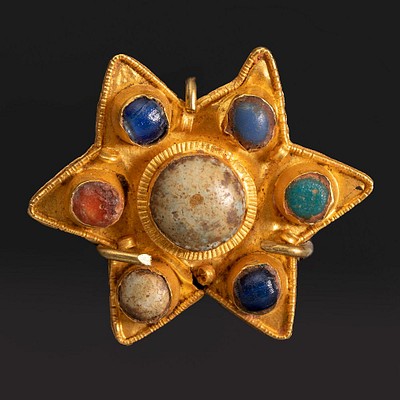AURELIO TENO TENO (Mina del Soldado, 1927 - Córdoba, 2013). "Rapture of Europe". Mixed media on paper.
Lot 123
About Seller
Setdart Auction House
Carrer Aragó 346
Barcelona
Spain
Setdart Subastas was born in 2004 and is currently the first online art auction in Spain with solidity, prestige and reliability guaranteed by our more than 60,000 users. Setdart has a young, dynamic and enterprising team ready to successfully manage the purchase and sale of art works through custom...Read more
Categories
Estimate:
EUR€2,000 - EUR€2,500
$2,083.33 - $2,604.17
Absentee vs Live bid
Two ways to bid:
- Leave a max absentee bid and the platform will bid on your behalf up to your maximum bid during the live auction.
- Bid live during the auction and your bids will be submitted real-time to the auctioneer.
Bid Increments
| Price | Bid Increment |
|---|---|
| EUR€0 | EUR€10 |
| EUR€200 | EUR€25 |
| EUR€500 | EUR€50 |
| EUR€1,000 | EUR€100 |
| EUR€3,000 | EUR€200 |
| EUR€5,000 | EUR€500 |
| EUR€10,000 | EUR€1,000 |
| EUR€20,000 | EUR€2,000 |
| EUR€50,000 | EUR€5,000 |
About Auction
By Setdart Auction House
Dec 21, 2021
Set Reminder
2021-12-21 07:30:00
2021-12-21 07:30:00
America/New_York
Bidsquare
Bidsquare : Córdoba: 2,000 Years of Art
https://www.bidsquare.com/auctions/setdart-auction-house/c-rdoba-2-000-years-of-art-8049
Setdart Auction House sofia@setdart.com
Setdart Auction House sofia@setdart.com
- Lot Description
AURELIO TENO TENO (Mina del Soldado, 1927 - Córdoba, 2013). "Rapture of Europe". Mixed media on paper. Signed, dated and located in the lower right area. Measurements: 51 x 37 cm; 58,5 x 46,5 cm (frame). Aurelio Teno Teno was a Spanish sculptor and painter noted for his interpretations of Don Quixote, represented as the first cosmonaut in history. Between 1936 and 1943 he lived in Cordoba where he received his artistic training. First as an apprentice in the workshop of sculptor Amadeo Ruiz Olmos, then in a silversmith's workshop, and from 1939 at the School of Arts and Crafts in Cordoba, where he studied painting and drawing. In 1950 he moved to Madrid to work as a goldsmith, and later to Paris where he lived for ten years. There he furthered his studies in fine arts, receiving influences from Giacometti and expressionism. He held several painting exhibitions in the galleries Salón del Art Libre, Palais des Beaux Arts and others. At the same time, he dedicated himself to the creation of jewelry-sculptures. In 1965 he returned to Madrid, although he set up his studio in the Molino del Cubo (Ávila) where he investigated new plastic procedures. During this period he exhibited at the Ateneo de Madrid. From that year on, he began a series of international exhibitions in Copenhagen, Paris, New York, Rabat and St. Louis (Missouri), obtaining great artistic recognition and consolidating his international prestige as a monumental sculptor by winning the competition to create the sculpture of Don Quixote, which would be erected in front of the Kennedy Center in Washington, in competition with Salvador Dalí and José de Creeft. He finally set up his workshop, and a museum dedicated to his work, in the old monastery of Pedrique (near Villaharta), in the municipality of Pozoblanco.
- Shipping Info
-
In-house shipping available. Please inquire at admin@setdart.com.
-
- Buyer's Premium



 EUR
EUR CAD
CAD AUD
AUD GBP
GBP MXN
MXN HKD
HKD CNY
CNY MYR
MYR SEK
SEK SGD
SGD CHF
CHF THB
THB















